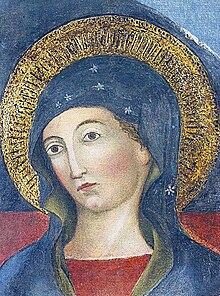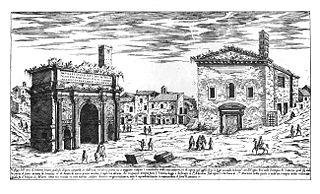
The Basilica of Saint Clement is a Latin Catholic minor basilica dedicated to Pope Clement I located in Rome, Italy. Archaeologically speaking, the structure is a three-tiered complex of buildings: (1) the present basilica built just before the year 1100 during the height of the Middle Ages; (2) beneath the present basilica is a 4th-century basilica that had been converted out of the home of a Roman nobleman, part of which had in the 1st century briefly served as an early church, and the basement of which had in the 2nd century briefly served as a mithraeum; (3) the home of the Roman nobleman had been built on the foundations of republican era villa and warehouse that had been destroyed in the Great Fire of AD 64.

Sant'Andrea della Valle is a minor basilica in the rione of Sant'Eustachio of the city of Rome, Italy. The basilica is the general seat for the religious order of the Theatines. It is located at Piazza Vidoni, at the intersection of Corso Vittorio Emanuele and Corso Rinascimento.

The Basilica of Santa Maria in Trastevere ; English: Our Lady in Trastevere) is a titular minor basilica in the Trastevere district of Rome, and one of the oldest churches of Rome. The basic floor plan and wall structure of the church date back to the 340s, and much of the structure to 1140–43. The first sanctuary was built in 221 and 227 by Pope Callixtus I and later completed by Pope Julius I. The church has large areas of important mosaics from the late 13th century by Pietro Cavallini.

There are more than 900 churches in Rome, which makes it the city with the largest number of churches in the world. Almost all of these are Catholic.

San Martino ai Monti, officially known as Santi Silvestro e Martino ai Monti, is a minor basilica in Rome, Italy, in the Rione Monti neighbourhood. It is located near the edge of the Parco del Colle Oppio, near the corner of Via Equizia and Viale del Monte Oppio, about five to six blocks south of Santa Maria Maggiore.

San Marco is a minor basilica in Rome dedicated to Saint Mark the Evangelist located in the small Piazza di San Marco adjoining Piazza Venezia. It was first built in 336 by Pope Mark, whose remains are in an urn located below the main altar. The basilica is the national church of Venice in Rome.

The early Christian imperial basilica of the Saints Martyrs Vitale, Valeria, Gervasio and Protasio known more commonly as the basilica of San Vitale and Compagni Martiri in Fovea or more simply as San Vitale al Quirinale. It is the oldest Catholic place of worship in the historic center of Rome, located in via Nazionale. The imperial basilica of San Vitale al Quirinale, built under the pontificate of Pope Siricius after 386 and consecrated and richly decorated by Pope Innocent in 402 is the first public Christian basilica with a baptistery not founded on pre-existing pagan temples, mentioned in the Liber pontificalis, built by the Emperor Theodosius at the behest of Saint Ambrose of Milan, in honor of the miraculous discovery of the bodies of martyrs Gervasius and Protasius in Milan. It is the most frescoed basilica in Rome.

Santa Maria della Pace is a church in Rome, central Italy, not far from Piazza Navona. The building lies in rione Ponte.

The Basilica of St. Bartholomew on the Island is a titular minor basilica, located in Rome, Italy. It was founded in 998 by Otto III, Holy Roman Emperor and contains the putative relics of St. Bartholomew the Apostle. It is located on Tiber Island, on the site of the former temple of Aesculapius, which had cleansed the island of its former ill-repute among the Romans and established its reputation as a hospital, continued under Christian auspices today.

The basilica of San Pancrazio is a Roman Catholic ancient basilica and titular church founded by Pope Symmachus in the 6th century in Rome, Italy. It stands in via S. Pancrazio, westward beyond the Porta San Pancrazio that opens in a stretch of the Aurelian Wall on the Janiculum. It covers the Catacomb of San Pancrazio.
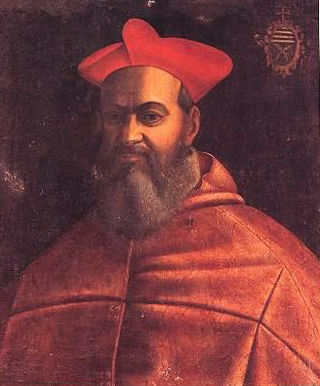
Scipione Rebiba was an Italian prelate of the Catholic Church, a protégé of Gian Pietro Carafa, who became Pope Paul IV. He held a variety of positions in the Church hierarchy, including some of the most senior. He introduced the Inquisition to Naples in the 1550s and became a cardinal in 1555. He is mostly known today for having been the earliest bishop to whom most Roman Catholic bishops can trace their apostolic succession, as it is unknown who consecrated Rebiba.

Sant'Angelo in Pescheria or in Piscaria is a church in Rome. It dates from the 8th century. "In Pescheria" refers to its location close to the fish market built in the ruins of the ancient Porticus Octaviae.
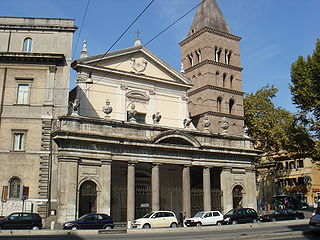
San Crisogono is a church in Rome dedicated to the martyr Saint Chrysogonus. It was one of the tituli, the first parish churches of Rome, and was probably built in the 4th century under Pope Sylvester I (314–335).
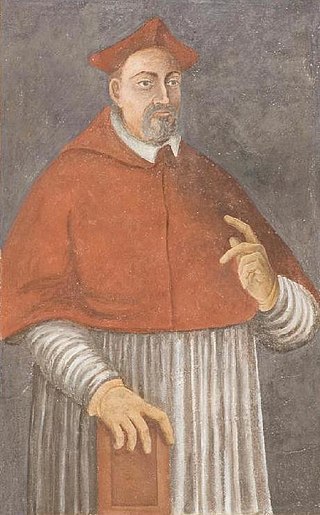
Francesco Pisani was an Italian Cardinal, born in Venice, the son of Alvise Pisani the noted banker, who was Procurator of S. Mark's, a member of the Council of Ten, and a Councilor of the Doge of Venice; and Cecilia Giustinian. He had a brother named Giovanni (Zuan), who also became Procurator of S. Marks' and was a Venetian diplomat; he was married to the sister of Doge Andrea Gritti. He was a strong supporter of the alliance between Venice, France and the Papacy, called the League of Cognac. He shared the imprisonment of Pope Clement VII in the Castel S. Angelo during the Sack of Rome and its aftermath. He spent eighteen months in exile in Naples while Clement made his peace with the Emperor Charles V.

The Church of Saint Athanasius, also known as Sant'Atanasio dei Greci, is a Greek Catholic titular church located on Via del Babuino 149, near the Spanish steps, in the rione Campo Marzio of Rome, Italy.

Carlo Rossetti (Roscetti) (1614 – 23 November 1681) was an Italian Catholic Cardinal, born of the noble Rossetti family in Ferrara. Earlier in his career he went to London as a secret nuncio on behalf of Pope Urban VIII. While in London, he was addressed as Lord Charles Rossetti and was referred to as Prince Rossetti, using his title as Italian nobility for his cover, rather than as a representative of the Roman Catholic Church to avoid persecution.
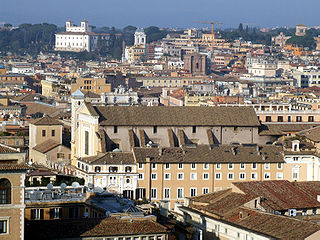
Santi Dodici Apostoli, commonly known simply as Santi Apostoli, is a 6th-century Roman Catholic parish and titular church and minor basilica in Rome, Italy, dedicated originally to St. James and St. Philip, whose remains are kept here, and later to all Apostles. Today, the basilica is under the care of the Conventual Franciscans, whose headquarters in Rome is in the adjacent building. It is the Station church for Friday, the first week of Lent.

Fulvio Giulio della Corgna was a Tuscan Catholic bishop and cardinal.

Arcangelo de' Bianchi was an Italian Roman Catholic cardinal and bishop.



